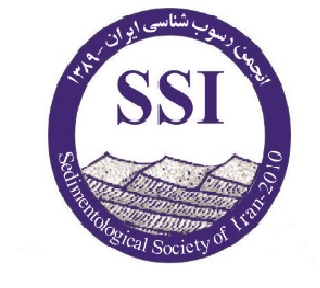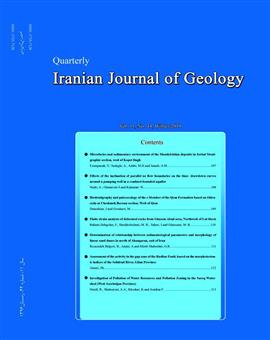Effects of the inclination of parallel no flow boundaries on the time- drawdown curves around a pumping well in a confined bounded aquifer
Subject Areas :Arash Nadri 1 , ezatolah ghanavati 2 , Nasrolah Kalantari 3
1 -
2 -
3 -
Keywords: No flow boundaries Time-Drawdown data Confined aquifers Numerical simulation Image wells,
Abstract :
The image well theory was used in the study of no flow boundaries effects on the drawdown around pumping wells. Most studies are concentrated on the vertical no flow boundaries, while, in some cases these boundaries are not vertical and have inclinations. To the best of the authors knowledge, the problem of the inclined no flow boundaries has not been studied yet. The effects of the parallel no flow boundaries inclination on the drawdown around pumping wells in bounded aquifers is studied here. The time-drawdown data for vertical boundaries have used the numerical simulation and also the image well theory. The effects of inclination of the boundaries were only considered using the numerical simulation. The results of numerical simulations and image well theory for vertical no flow boundaries were matched completely. The computed drawdown for observation well in the models with inclined and vertical no flow boundaries used to compute the difference between them. The difference between these cases depends on the distance between the boundaries (width of the aquifer) and the inclination value. The results showed that in large widths and low inclinations, the computed drawdown in aquifers with vertical boundaries are almost similar with the computed drawdown in aquifers with inclined boundaries and the differences can be neglected. In the other words, the difference between the vertical and inclined cases in smaller widths is so high that even in the low inclinations, the differences can't be neglected. It can be concluded that the image well theory as we know, cannot be used in inclined no flow boundaries.
Barrash, W. and Dougherty, M. E., 1997. Modeling Axially Symmetric and Nonsymmetric Flow to a Well with MODFLOW, and Application to Goddard2 Well Test, Boise, Idaho. Ground Water, 35, 602–611.
Chan Y. K., 1976. Improved image-well technique for aquifer analysis. Journal of Hydrology, 29 (1), 149-164.
Chen, Y., Yeh, H., and Yang, S., 2009. Analytical Solutions for Constant-Flux and Constant-Head Tests at a Finite-Diameter Well in a Wedge-Shaped Aquifer. Journal of Hydraulic Engineering, 133 (4), 333-337.
Davis, S. and Dewiest R., 1966. Hydrogeology. John Wiley and Sons. New York 463.
Dietz, D., 1943. De Toepassing van Invloedsfuncties bij het Berekenen van de Verlaging van het Grondwater ten Gevolge van Wateronttrekking. Water, 27 (6), 51-57.
Ferris, J. G., Knowles, D. B, Brown, R. H. and Stallman, R. W., 1962. Theory of aquifer tests. Water-Supply Paper 1536-E. US Geological Survey. United States Government Printing Office, Washington.
Forchheimer, P., 1886. Ueber die ergiebigkeit von brunnen-anlagen und sickerschlitzen. Zeitschr des Architekten-und Ingenieur-Vereines, 32, 539-563.
Hantush, M. S., 1959. Analysis of data from pumping wells near a river. Journal of Geophysical Research, 64(11), 1921-1932.
Harbaugh A. W., 2005. MODFLOW-2005, The U.S. Geological Survey Modular Ground-Water Model- the Ground-Water Flow Process. U.S. Geological Survey Techniques and Methods 6-A16
Intaraprasong T. and Zhan H. B., 2007. Capture zone between two streams. Journal of Hydrology, 338 (3–4), 297-307.
Kasenow, M., 1997. Ground-water Hydrology and Well Hydraulics. Water Resources Publications, LLC, Highlands Ranch, Colorado.
Kompani-Zare M. and Zhan H. B., 2005. Steady flow to a horizontal drain in an unconfined aquifer with variable thickness. Journal of Hydrology, 327 (1–2) 174-185.
Kompani-Zare M., Zhan H. B. and Samani N., 2004. Analytical study of capture zone of a horizontal well in a confined aquifer. Journal of Hydrology, 307 (1–4) 48-59.
Kruseman, G. P. and de Ridder, N. A., 1990. Analysis and Evaluation of Pumping Test Data (Second edition). Wageningen, the Netherlands: International Institute for Land Reclamation and Improvement. ISBN 90-70754-20-7.
Kuo, M. C. T., Wang, W. L., Lin, D. S. and Chiang, C. J., 1994. An image-well method for predicting drawdown distribution in aquifers with irregularly shaped boundaries. Ground Water, 32 (5), 794-804.
Lang, S., 1963. Drawdown patterns in aquifers having a straight-line boundary. Shortcuts and Special Problems in Aquifer Tests. US Geological Survey Water-Supply Paper: 56-68.
Moulder, E., 1963. Locus circles as an aid in the location of a hydrogeologic boundary. US Geological Survey Water-Supply Paper, 110-112.
Muskat, M., 1937. The Flow of Homogeneous Fluids through Porous Media. McGraw-Hill Book Company, Incorporated.
Reilly, T. E., 2004. A brief history of contributions to ground water hydrology by the US Geological Survey. Ground water, 42(4), 625-631.
Rubin, Y. and Dagan G., 1989. Stochastic analysis of boundaries effects on head spatial variability in heterogeneous aquifers: 2, impervious boundary. Water Recourses Research, 25(4), 707–712.
Samani, N. and Zarei-Doudeji S., 2012. Capture zone of a multi-well system in confined and unconfined wedge-shaped aquifers. Advances in Water Resources, 39 ,71-84.
Stallman, R. W., 1952. Nonequilibrium type curves modified for two-well systems. US Geological Survey, open-file chart (Ground Water Notes No. 3).
Stallman, R. W., 1963. Type curves for the solution of single-boundary problems. Bentall, Ray, Shortcuts and special problems in aquifer tests: US Geological Survey Water-Supply Paper: C45-C47.
Theis, C. V., 1935. The relation between the lowering of the piezometric surface and the rate and duration of discharge of a well using groundwater storage. Transactions of the American Geophysical Union 16, 519–524.
Todd, D. and Mays L., 2005. Groundwater Hydrology. Third edition, John Wiley and Sons, Inc.
Vandenberg, A., 1976. Tables and type curves for analysis of pump tests in leaky parallel-channel aquifers. Technical Bulletin no 96, Inland waters Directorate, Water Resources Branch, Ottawa.
Vandenberg, A., 1977. Type curves for analysis of pump tests in leaky strip aquifers. Journal of Hydrology. 33(1), 15-26.
Zarei-Doudeji, S. and Samani N., 2014. Capture zone of a multi-well system in bounded peninsula-shaped aquifers. Journal of Contaminant Hydrology 164, 114-124.

